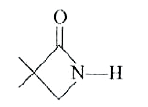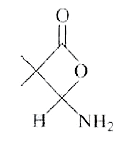(a). CuSO4.5H2O100∘−−→(A)230∘−−→(B)800∘−−→(C)+(D)
(b). AgNO3redhot−−−→(E)+(F)+O2
Let's break down the reactions step by step:
Part (a): Decomposition of Copper(II) Sulfate Pentahydrate
1. Starting Compound: Copper(II) sulfate pentahydrate, CuSO4⋅5H2O.
2. Heating at 100°C: When CuSO4⋅5H2O is heated to 100°C, it loses 4 water molecules and forms:
CuSO4⋅H2O(Compound A)
3. Heating at 230°C: When CuSO4⋅H2O is further heated to 230°C, it loses the remaining water molecule and converts to:
CuSO4(Compound B)
4. Heating at 800°C: Finally, when CuSO4 is heated to 800°C, it decomposes into:
CuO+SO3(Compound C and D)
Summary of Part (a):
- A=CuSO4⋅H2O
- B=CuSO4
- C=CuO
- D=SO3
---
Part (b): Decomposition of Silver Nitrate
1. Starting Compound: Silver nitrate, AgNO3.
2. Heating Red Hot: When AgNO3 is heated red hot, it decomposes into:
Ag+NO2+O2
Here, NO2 is produced as a gas.
3. Balancing the Reaction: The balanced equation for the decomposition of silver nitrate is:
2AgNO3→2Ag+2NO2+O2(Compound E and F)
Summary of Part (b):
- E=Ag
- F=NO2
---
Final Products:
- From part (a):
- A=CuSO4⋅H2O
- B=CuSO4
- C=CuO
- D=SO3
- From part (b):
- E=Ag
- F=NO2
---
2. Heating at 100°C: When CuSO4⋅5H2O is heated to 100°C, it loses 4 water molecules and forms:
CuSO4⋅H2O(Compound A)
CuSO4(Compound B)
CuO+SO3(Compound C and D)
- A=CuSO4⋅H2O
- B=CuSO4
- C=CuO
- D=SO3
Ag+NO2+O2
Here, NO2 is produced as a gas.
2AgNO3→2Ag+2NO2+O2(Compound E and F)
- E=Ag
- F=NO2
- From part (a):
- A=CuSO4⋅H2O
- B=CuSO4
- C=CuO
- D=SO3
- From part (b):
- E=Ag
- F=NO2
Topper's Solved these Questions
- D AND F BLOCK ELEMENTSBook:CENGAGE CHEMISTRY ENGLISHChapter:D AND F BLOCK ELEMENTSExercise:Ex 6.1 Subjective
Explore 12 Videos
- D AND F BLOCK ELEMENTSBook:CENGAGE CHEMISTRY ENGLISHChapter:D AND F BLOCK ELEMENTSExercise:Ex 6.2 Subjective (Compound Of Fe :)
Explore 7 Videos
- D AND F BLOCK ELEMENTSBook:CENGAGE CHEMISTRY ENGLISHChapter:D AND F BLOCK ELEMENTSExercise:Archives Subjective
Explore 29 Videos
- COORDINATION COMPOUNDSBook:CENGAGE CHEMISTRY ENGLISHChapter:COORDINATION COMPOUNDSExercise:Archives Subjective
Explore 18 Videos
- ELECTROCHEMISTRYBook:CENGAGE CHEMISTRY ENGLISHChapter:ELECTROCHEMISTRYExercise:Archieves Subjective
Explore 35 Videos
Similar Questions
Knowledge Check
The end product in the reaction is :
CH3CONH2P2O5−−→BH2,Ni−−−→CHNO2−−−→DCu−−−−−→300∘EACH3CHOBCH3COCH3CCH3COOC2H5D(CH3CO)2OConsider the following sequence of reactions :
HO−O∣∣C−CH3∣C∣CH3−C≡N200∘C−−−→ALiAIH4−−−−−−→H2OB, (B) isA B
B CHO−H2C−CH3∣C∣CH3−CH2−NH2D
CHO−H2C−CH3∣C∣CH3−CH2−NH2D
Identify the compounds A,B and C :
(a) C2H5OHPCl5−−→AKCN−−→BH3O+−−−→C2H5COOHNH3−−−−−→ΔC
(b) C6H5COOHSOCl2−−−→ANH3−−→BBr2/KOH−−−−−−→C
View Solution(i) Identify A to F:
ALiAIH4−−−−→C2H5OHPBr3−−→BKCN−−→CD−−→C3H7NH2HNO2−−−→E[O]−−−−−−−−→K2Cr2O7/H+F
(ii) How can the following conversion be brought about : propanoic acid to ethylamine.
View SolutionIn the following identify the compounds/reaction conditions represented by the alphabets (A),(B), and (C) :
C6H5COOHPCl5−−→(A)NH3→(B)P2O5−−−→C6H5CNH2/Ni−−−−→(C).
View SolutionIdentify the reagents A,B,C,D,E and F required for the following conversion: C6H5NO2A−−→C6H5NH2B−−→C6H5N2+Cl−C−−→C6H5ClDC6H5OHH2SO4−−−→E+F.
View SolutionWrite the product of following reactions :
(a) CH3−H3C∣C=CH3∣C−CH3O3−−−−−→Zn/H2O , (b) CH3−C≡C−CH3O3−−−−−→Zn/H2O
( c) CH3−C≡C−CH3O3/H2O2−−−−−→ , (d) CH3−CH3∣C=CH−CH3O3/H2O2−−−−−→
View SolutionFor the given four structures , I to IV, which of the following is correct ?
C2H5−CH3∣CH−C3H7(I) CH3−OPC−CH3∣CH−C2H5(II)CH3−OPC−C2H5∣CH−C2H5(III) C2H5−CH3∣CH−C2H5(IV)
View Solution